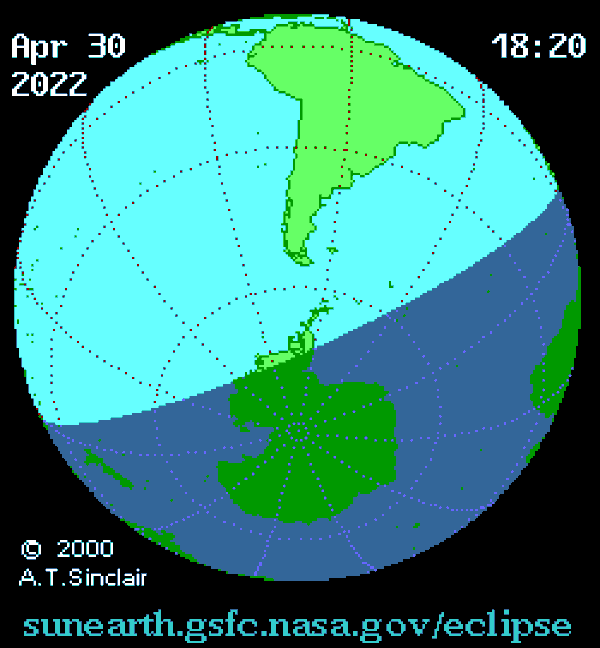How to watch the April 2022 solar eclipse online
Update for 6:14 pm ET: TimeandDate.com's webcast for the partial solar eclipse of April 30, 2022 from Chile and Argentina has ended as the sun has set during mid-eclipse. Check out the amazing views from the video above. Read our full wrap story on the solar eclipse.
The first solar eclipse of 2022 arrives this week across parts of the Southern Hemisphere — here's how you can watch the event live online from other parts of the world.
On April 30, a partial solar eclipse will be visible over parts of Antarctica, South America and the Pacific and Atlantic oceans. While skygazers in the U.S. won't get to see the partial solar eclipse in person, they can watch a livestream of the celestial event online.
The partial solar eclipse of April 2022 will first be visible at 2:45 p.m. EDT (1845 GMT). The maximum eclipse will happen a couple of hours later, at 4:41 p.m. EDT (2041 GMT). Then, the eclipse will end at 6:37 p.m. EDT (2237 GMT), according to TimeandDate.com.
Related: Partial solar eclipse of April 2022: When, where and how to see it
A solar eclipse occurs when the moon passes between Earth and the sun, and, in this case, partly obscures the sun as it appears from Earth. The eclipse gives the sun a crescent shape, as if a "bite" has been taken out of the sun. The portion of the sun blocked by the moon varies depending on the viewer's location, with a maximum 64% of the sun's disk obscured by the moon as seen from just south of the southern tip of South America, according to NASA.

Timeanddate.com solar eclipse webcast
Timeanddate.com will now host a live webcast for the solar eclipse as part of its live blog of the event. The solar eclipse coverage will begin at 3:30 p.m. EDT (1930 GMT) and should run through the peak of the event, weather permitting.
Get the Space.com Newsletter
Breaking space news, the latest updates on rocket launches, skywatching events and more!
Coverage is already available online, with Timeanddate.com posting skywatching event information in the days leading up to the solar eclipse. Timeanddate.com has partnered with the Instituto de Astrofísica at Pontificia Universidad Católica in Chile for the event, as well as with a group of astronomers across Argentina led by the Instituto Latinoamericano de Astroturismo.
As a reminder for skywatchers located within the visibility area, never look at the sun directly with your eyes. It is important to wear special protective eyewear or certified eclipse glasses in order to safely observe the sun or watch an eclipse. Using the wrong gear (or using it incorrectly) can burn your retinas, causing irreparable damage to your eyes.
The safest way to observe an eclipse is through indirect methods, such as using a pinhole camera, which is easy to make at home. You can also check out our guide for how to photograph a solar eclipse.
Gyaan ki gareebi Live solar eclipse webcast
For those who can't catch it in person, there will be at least one livestream of the event available to watch online. The YouTube channel Gyaan ki gareebi Live will begin broadcasting the partial solar eclipse at 1:45 p.m. EDT (1745 GMT). It will last about five hours.
Weather permitting, the webcast will show live views of the solar eclipse from Cerro Shenolsh in the Tierra del Fuego province of Argentina, the YouTube channel told Space.com. Gyaan ki gareebi is an India-based YouTube streamer who broadcasts live views of full moons, rocket launches and other space events. Their solar eclipse webcast is expected to run the length of the April 30 solar eclipse, from start to finish.
If more live webcasts are announced, we'll include them here.
Soluna Solar Eclipse Glasses (10 pack) $99.99 now $12.99 on Amazon.
Prepare for the next solar eclipse and save 88% on these solar eclipse glasses that are made by a NASA-approved manufacturer. They've been independently tested for direct sunlight viewing and score highly with thousands of reviews. Perfect if you're viewing the solar eclipse as a group.
Note: the original price is very high so there's a chance this is so to make it look like a bigger deal, the price you pay is still a good one though.
The April 30 eclipse will be the first of two partial solar eclipses in 2022. The second will occur on Oct. 25, then we won't see another total solar eclipse until 2023. However, a total lunar eclipse follows this month's partial solar eclipse only two weeks later, on May 16.
This week's eclipse also coincides with the second new moon of April, also known as a Black Moon. Typically, a new moon occurs only once a month, when the Earth-facing side is fully cloaked in shadow. However, April began with a new moon on April 1, making April 30 the second new moon of the month.
Editor's Note: If you snap an amazing solar eclipse photo and would like to share it with Space.com's readers, send your photo(s), comments, and your name and location to spacephotos@space.com.
Follow Samantha Mathewson @Sam_Ashley13. Follow us on Twitter @Spacedotcom and on Facebook.
Join our Space Forums to keep talking space on the latest missions, night sky and more! And if you have a news tip, correction or comment, let us know at: community@space.com.

Samantha Mathewson joined Space.com as an intern in the summer of 2016. She received a B.A. in Journalism and Environmental Science at the University of New Haven, in Connecticut. Previously, her work has been published in Nature World News. When not writing or reading about science, Samantha enjoys traveling to new places and taking photos! You can follow her on Twitter @Sam_Ashley13.










